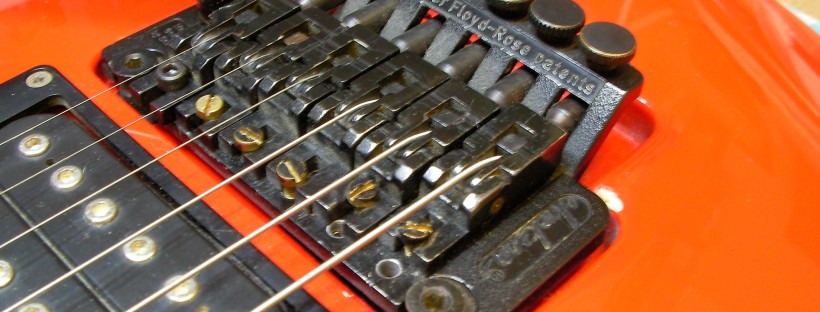I see this question asked a lot online, and I can imagine the scenario. You’ve bought a guitar with a floating tremolo system and you can’t keep it in tune for the life of you. You’ve locked the top nut and everything looks right, but yet when you use the bar even a bit, things start to drift. Floyds can be a pain at the best of times, but a guitar that won’t stay in tune can be virtually unplayable, especially in a live music scenario. As with many things tech, it’s hard to tell the problem without actually seeing the guitar, but here are some of the common reasons and places that you can start.
Strings Knackered
If the strings on your guitar are old, worn and a bit rusty they are not going to stay in tune. They probably wouldn’t stay in tune even on a fixed bridge guitar, never mind a guitar with a floating trem. Get some new strings fitted – come on, they’re only a fiver. New strings make everything better, and will sound and feel nicer too.
Strings Not Stretched In
When you fit a new set of strings on a Floyd equipped guitar you need to stretch them in before they are ready to play. If you don’t, the strings will stretch gradually as you play and will go out of tune continuously for days or weeks. Manually stretching them in is pretty easy and takes about 10 minutes. Starting at one end, pull the string away from the guitar body/neck. Not too hard or too far, just until you feel it go tight in your hand Do this a couple of times. Now move up/down the string about 6 inches and do the same. Keep doing this until you’ve got to the other end of the string. Now retune the string (you’ll notice it’s gone massively flat). Repeat this process until the string absolutely refuses to go flat any more. Do this for all of the strings, and you’re done.
Loose Neck
A good floating trem setup demands that NOTHING moves apart from the body of the trem system. Everything else needs to be rock solid. If your bolt on neck is even slightly loose, it could move a fraction as you use the whammy bar. Check the neck screws and make sure they are nice and tight. Once you’ve checked that, try moving the neck left and right to see if there is any sideways play – there shouldn’t be any at all. If the neck DOES move a bit, take it to a tech. It could have been shimmed badly, or the screw threads in the neck could be stripped, meaning that the joint won’t go as tight as it needs to be.
Loose Nut
For the same reasons as above, the locking nut needs to be tightly fixed to the neck. Some locking nuts have bolts that go through the neck, some are just screwed in from above. regardless of which type yours is, use either a screwdriver or allen key and tighten them up. NOTE: don’t go crazy and strip the thread – just nicely nipped up will do.
Trem Binding On Body
The only part of the trem unit that touches the guitar body should be the section that sits on the trem posts (the pivot) and the spring-to-body arrangement in the back cavity. Sometimes, if the trem has been badly fitted there can be points on the trem that actually touch the body as it moves forwards and backward. This will prevent the trem from reaching equilibrium and balancing correctly, and thus can cause the trem to go out of tune. The trem can also catch on badly fitted scratchplates. Check all around the trem body to see if it’s touching anything anywhere. if it is, take it to a tech.
Worn Knife Edges or Trem Posts
The trem baseplate sits in the two posts that are inserted in the body. The baseplate is very sharp in this area, and there is minimum contact are with the posts. This knife edge gives a friction free movement that allows the trem to always find its natural balance point and return perfectly to tune. If the posts or baseplate are worn, the trem will bind on the posts and will struggle to go back to exactly the same position each time, causing it to go out of tune.
With most trems, there’s not a lot you can do with blunt knife edges other than replace the baseplate. You can TRY to sharpen them up again, but by removing metal you are slightly changing the angle of the trem or the distance between the knife edge centres, and either of these can cause tuning problems in themselves. If you;re lucky to have a guitar with an Ibanez Edge, Edge Pro or Lo Pro trem you can actually remove and replace the knife edges as they are actually separate pieces.
As a last resort for worn posts or knife edges you can try to lubricate them to help things along. Turn the trem post half a turn anticlockwise to reveal the part where the baseplate touches. Put a tiny dab of lip salve on this point. Now turn the trem post back to where it was. This can help.
Springs / Spring Claw
Springs do wear out, and if your guitar is old they may be knackered and need replacing. Check the springs and the spring claw. The claw should be securely screwed into the body and should be relatively straight. The springs should be hooked onto the claw properly, and be located neatly all the way into the trem block.
Bad Setup
Last but not least is the setup. When a trem is set up properly, the knife edge of the trem should be at a 90 degree angle to the trem post. If your trem is sat back into the cavity, or sat up too high, the trem will not balance properly as the geometry will be all out. Adjusting the trem angle is all about adjusting the springs, retuning and adjusting some more til it’s spot on. If you don’t know where to start, take your guitar to a tech.
Hope that helps!


Thanks for the helpful tips.
LikeLiked by 1 person
You’re more than welcome! Thanks for reading 🙂
LikeLike
I have a 1980s American Peavey Tracer with a licensed by Floyd Rose that used to stay in tune great, but now will not. It does have a little wear on the fulcrum edge. I’ll try your lip balm suggestion. Also, I currently have two springs on the tremelo, would having all three spring be better in reference to staying in tune?
LikeLiked by 1 person
Hiya Ken,
Yes, the lip balm can help lubricate and it might make a few percent difference, although it does depend what’s causing the issue in the first place. As far as springs go, 2 or 3 springs should both be able to work fine.
Good luck with the guitar!
Jim
LikeLike